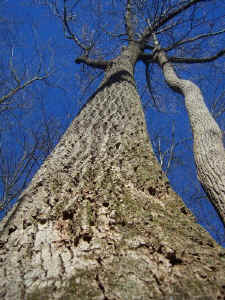| Robinson
Field Briefing 12/10/2006 |
rayof-@ndws.com |
| Dec
10, 2006 20:12 PST |
Hello all.
Bob Leverett and myself conducted a field trip and investigation
into Robinson State Park today. We were told of more tulip
poplars that had to be located and checked.

One of the tulip poplars at Robinson on a CLEAR COLD
morning
We discovered that there is a stand that runs along
a network of brooks and ravines, and joins a previous
group that we located early on. Totaling the trees
in this stand, its right at 35. This group is a distance
west of the "valley of the tulips", and the deep
ravine that contains
the big champs.
In addition, I rechecked a stand still further west from this
one, and
counted 15 in that stand. I'm told I missed a few by the local
group.
The GPS data wasn't great, hard to get satellite coverage today
in
the valleys. Need to go remap them all.
We tracked down a report of one lone tree way west of all of
these
but found no others near that one. Its on the riverbank.
So, we have now 45 additional trees to the 80 in the
"valley of the tulips"
stand, plus about a half dozen in the valley with the champs.
Most of these
are all 117 to 120 ft tall.
One alarming thing we did find is a couple of healthy tulips in
the 35 stand
that are marked for harvest in the proposed cutting plan. This
is in
addition to one that has some health issues. Also noted quite a
bit of harvest
taking place on slopes that go into small brooks.
Robinson is turning out to be the tulip poplar location of the
state at the
least, if not the Northeast.
Bob has some numbers on some other species we found and measured
as well.
Ray
|
| Robinson
SP |
Robert
Leverett |
| Dec
11, 2006 05:50 PST |
ENTS,
On Sunday, Ray Weber
and I spent 4 hours roaming around in
Robinson SP. We confirmed more tuliptrees as Ray explained in
his earlier
e-mail. We also confirmed a white pine to 128.3 feet, raising
the Rucker
index to 118.7. We will eventually push the index to 119 or
slightly
over, but that is where it will likely remain until natural tree
growth
allows a gain of a few 10th of a point. we did discover a
splendid
American sycamore with dimensions (111.7, 12.4). A second
sycamore
tipped the scales at a most respectable (112.7, 10.4), and a
third one
trailed at (107.6, 9.1). The tallest of the new tulips that we
measured
is (122.6, 7.7).
We noticed several tulips marked
for cutting, an action with no
justifiable ecological purpose. I suppose that we'll eventually
inventory between 130 and 140 tulips in Robinson that have their
crowns
in the canopy. This number will be out of a population of trees
in
Robinson that, I suspect, is between 60,000 and 90,000.
Robinson's tree
population needs to be determined for a variety of reasons.
However,
assuming for the sake of argument that the total number of
canopy trees
in Robison is 60,000 and further assuming that we eventually get
our
count of canopy tulips up to 150, then the tuliptree population
would
still account for at most a quarter of one percent of the trees
forming
the Robinson SP canopy. To be marking any of the seed-bearing
tulips for
cutting represents the myopic view of Robinson's forests as
valuable
mainly as a source of commercially valuable oak and pine - a
perception
of Robinson SP that is fatally flawed. It is a view that I do
not
believe is held by Massachusetts Chief Forester James DiMaio. It
is a
view that I believe is held by some of his staff.
Bob
|
| Re:
Robinson Field Briefing 12/10/2006 |
rayof-@ndws.com |
| Dec
11, 2006 14:28 PST |
They are not, if at all. We are now in meetings with DCR
to document the special nature of the park, and the flaws in
the idea to harvest there.
Ray
-----Original Message-----
From: Holly Post
Date: Mon, 11 Dec 2006 12:25:16 -0800 (PST)
Subject: Re: Robinson Field Briefing 12/10/2006
| |
Hi There: I thought they were not going to harvest at
Robinson for at least a year?
|
|
| Re:
Robinson Forest |
rayof-@ndws.com |
| Dec
14, 2006 20:30 PST |
A quick field trip report also, I checked out the opposite side
of the
river in the forest today, and found zero tulips there so far. I
checked
quite a few ravines with similar habitat as those in Robinson,
but
so far nothing. There have been a few sighted in an area that is
closed off for the winter. I may hike that later on when I have
more
time, or wait for spring. Most of the forest I looked at today
was
flood plain, with oak, white pine, hickory, and sycamore the
most
common, with a few beech seen.
Ray
|
|